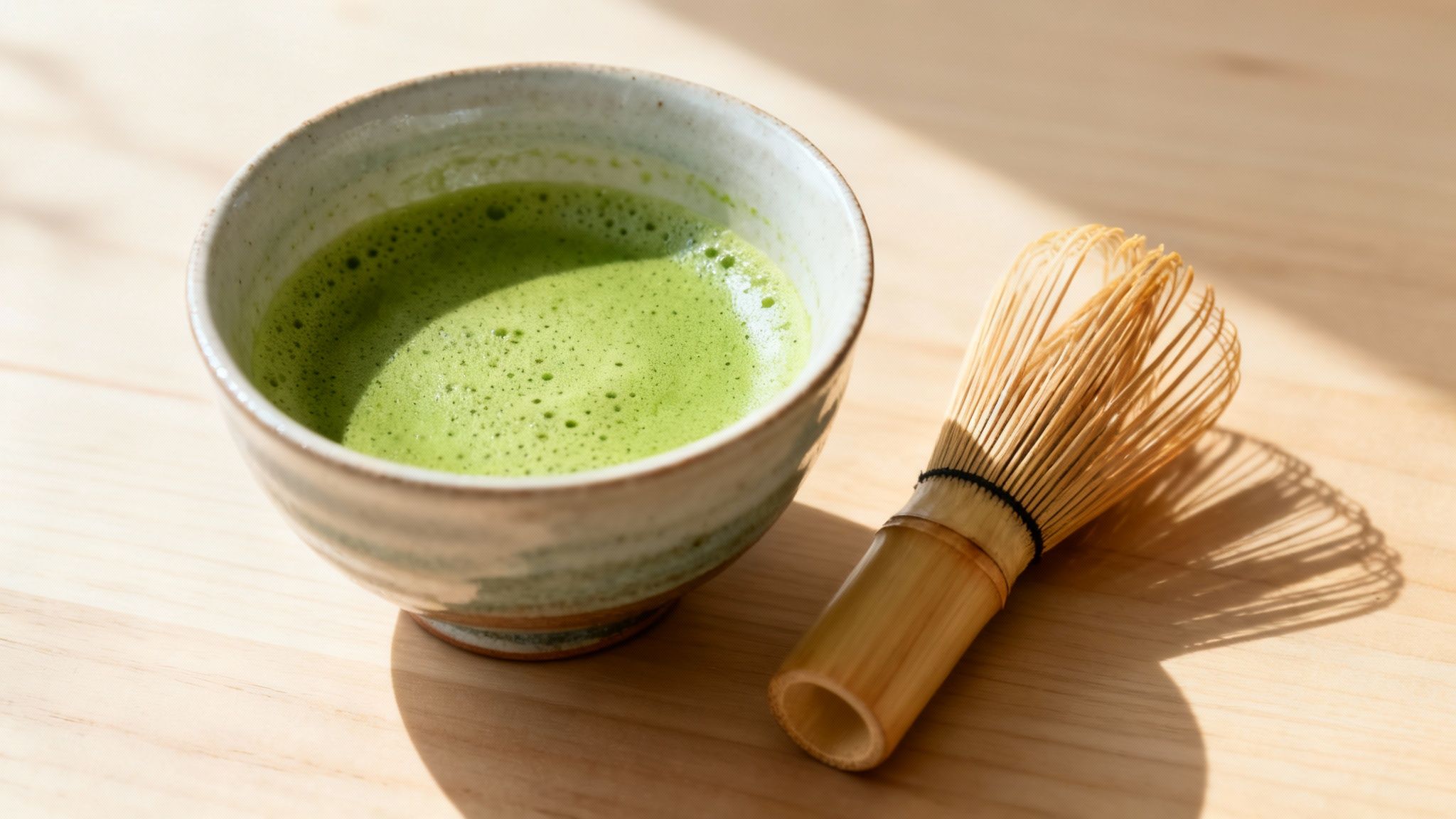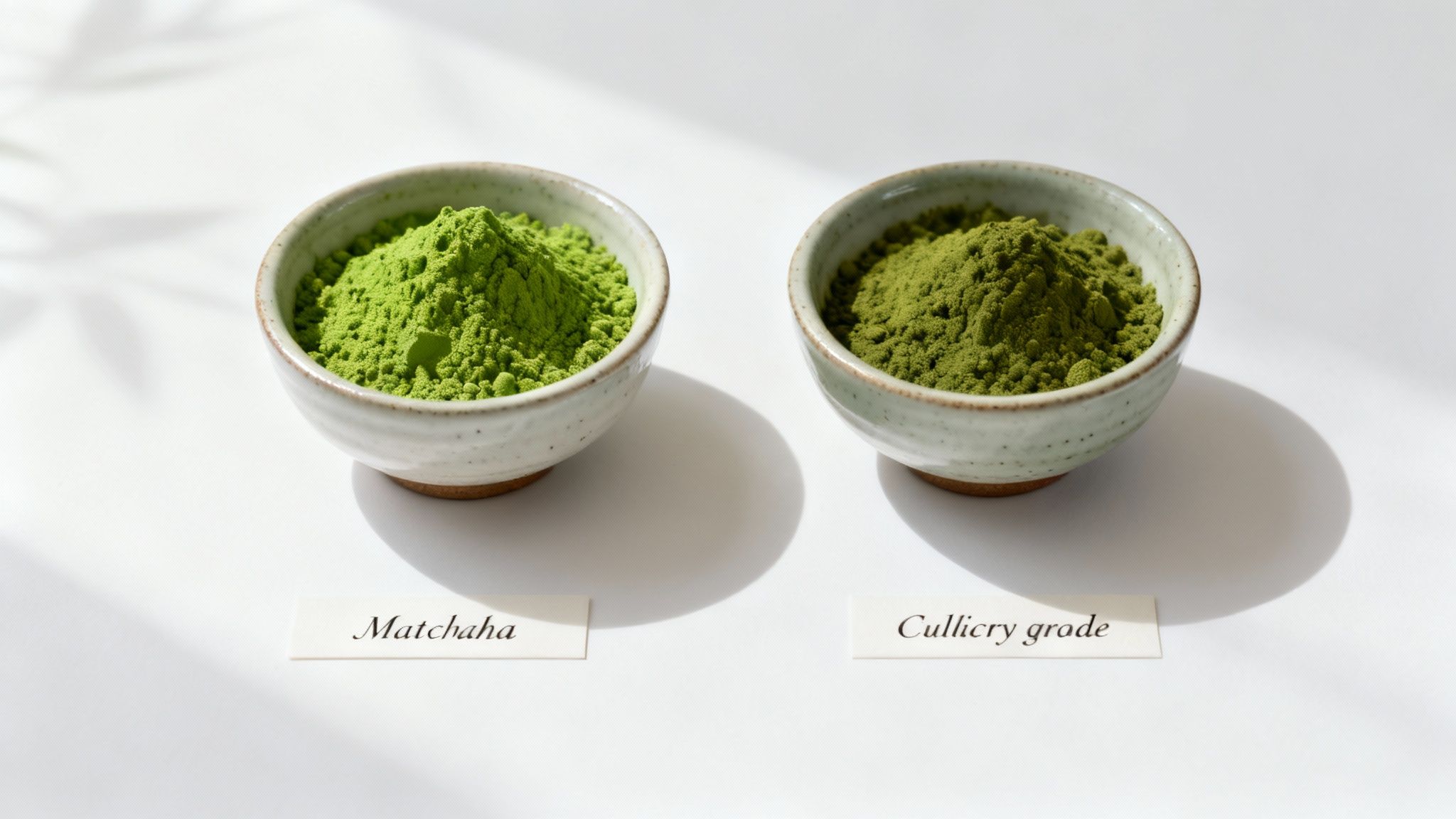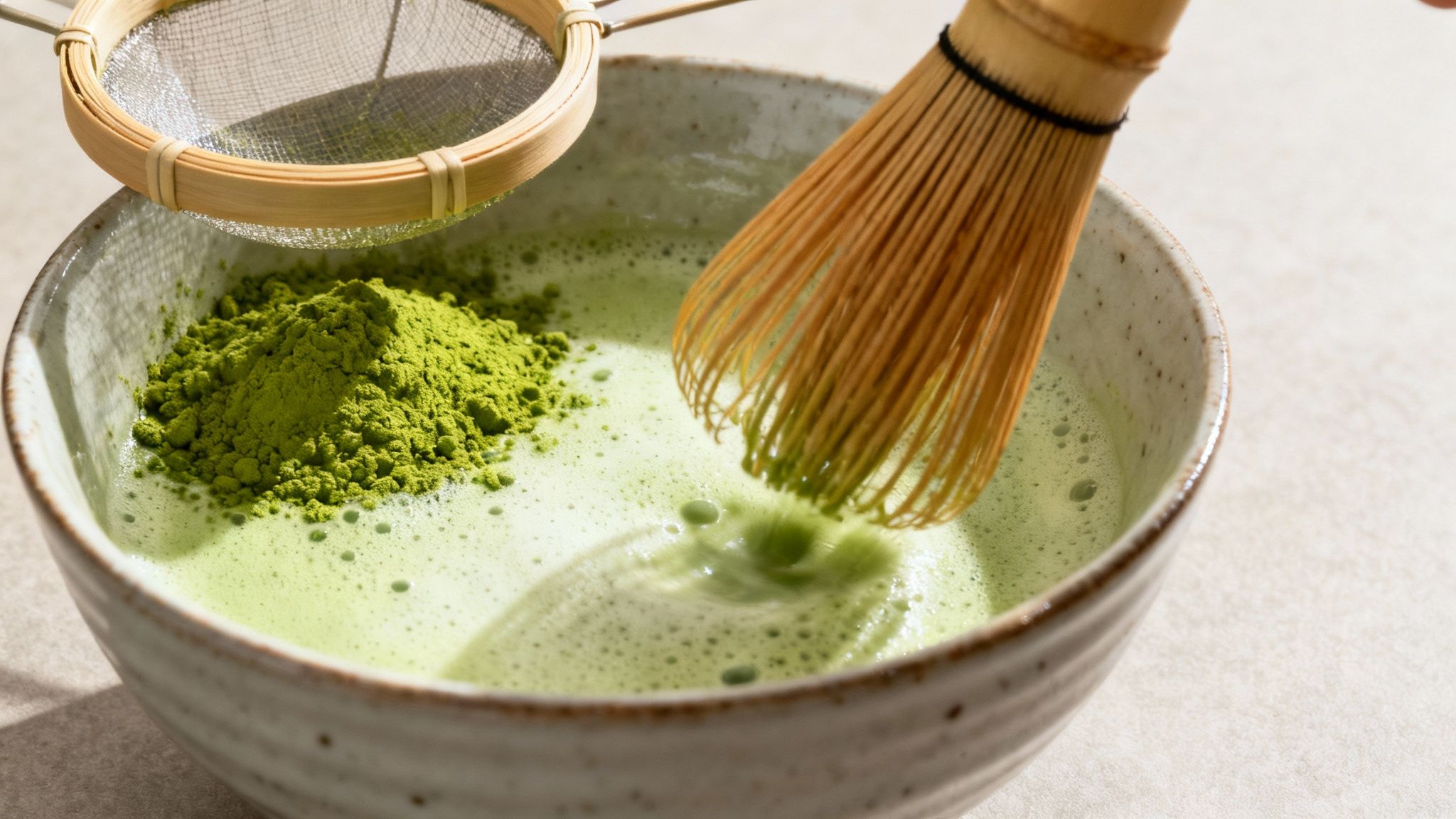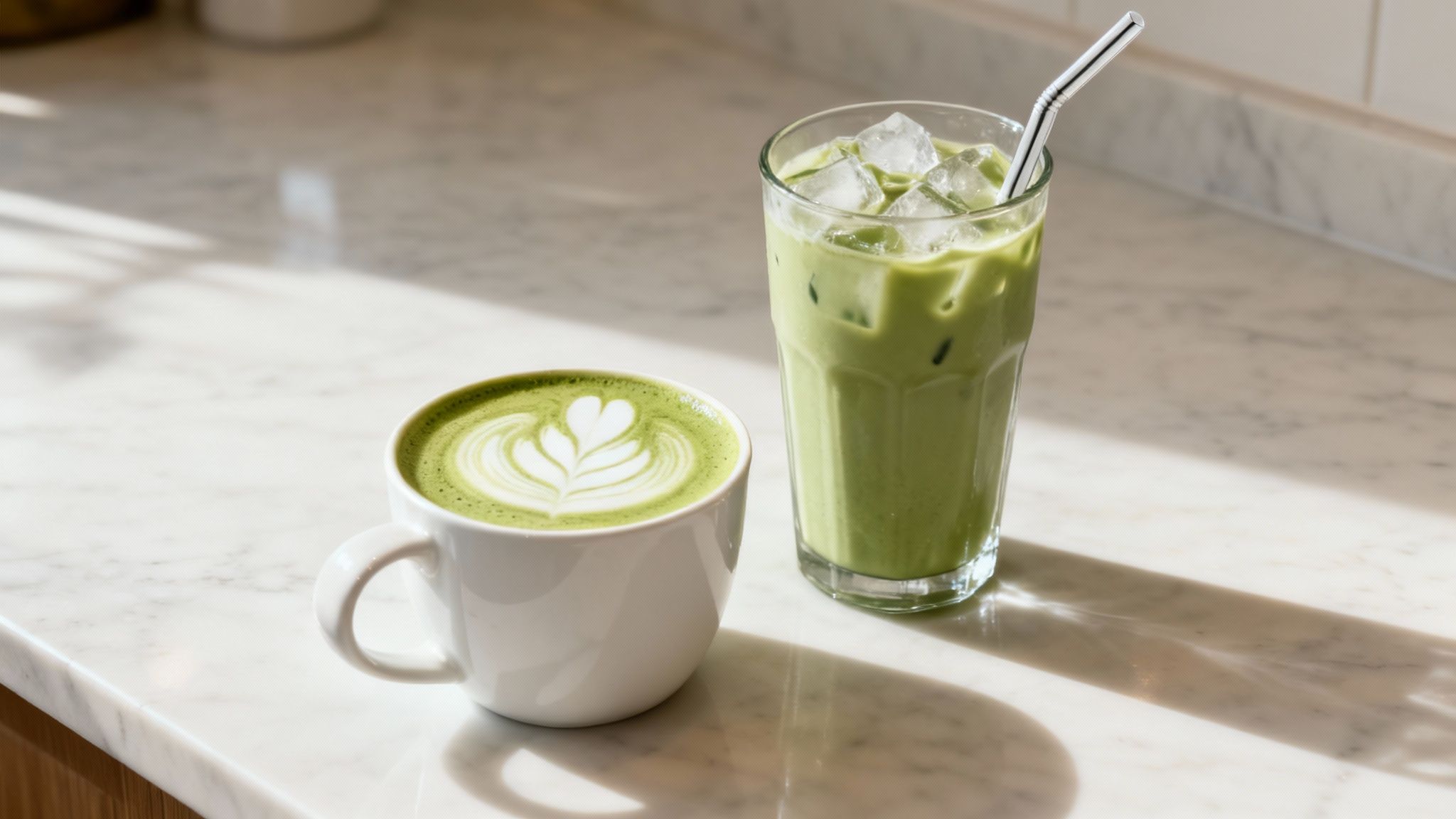To properly drink matcha tea, whisk one teaspoon of sifted matcha powder with 70ml of hot (not boiling) water until a light froth forms. This simple method unlocks its rich, umami flavour and creamy texture for the perfect daily ritual.
Your First Sip: A Modern Guide to Matcha
So, you’re ready to dive into the vibrant world of matcha. It’s far more than just another green tea; it's a unique experience that’s been winning over fans across the UK for its flavour and wellness benefits. This guide will show you exactly how to drink matcha tea, making it an easy and enjoyable part of your day, with or without the traditional ceremony.
The journey begins with understanding what makes matcha so different. With regular green tea, you steep the leaves in water and then toss them. But with matcha, you're actually consuming the entire leaf, which has been carefully ground into a fine, brilliantly green powder. This means you get a much more concentrated hit of flavour, caffeine, and nutrients.

Why Is Matcha So Popular Now?
The appeal of matcha goes well beyond its unique taste. It offers a combination of benefits that seem tailor-made for our modern lives. It’s celebrated for providing a calm yet focused energy—a welcome change from the jittery buzz that coffee can sometimes bring.
Here’s a quick look at why so many people are making the switch:
- Sustained Energy: Thanks to the amino acid L-theanine, matcha delivers a gentle, steady lift that won't leave you with an afternoon crash.
- Rich in Antioxidants: It's absolutely packed with catechins, especially EGCG, which are brilliant for supporting overall health.
- Mindful Ritual: The simple act of preparing matcha can be a wonderfully meditative and calming way to start your day.
The UK's love for matcha has absolutely skyrocketed, fuelled by a huge wellness boom and the explosion of matcha lattes in cafés from London to Manchester. It's become a staple on menus, and you'll find that the best premium grades often fly off the shelves.
Getting a delicious first taste really comes down to one thing: knowing the difference between ceremonial and culinary grades. We’ll get into that next, giving you the confidence to go from choosing the right powder to enjoying your first perfectly whisked cup. To explore the wellness advantages in more detail, you can learn more about matcha powder health benefits in our dedicated guide.
Choosing Your Perfect Matcha Grade

When you first start exploring matcha, you'll see words like "ceremonial" and "culinary" thrown around. It can feel a little confusing, but getting this part right is the single biggest key to a matcha experience you'll actually love. The grade you pick sets the stage for everything that follows—from flavour to texture.
So, what's the difference? It all comes down to which tea leaves are used.
Ceremonial grade is the best of the best. It's crafted from the youngest, most delicate leaves from the very top of the tea plant. These prized leaves are hand-picked, their stems and veins are removed, and they're slowly stone-ground into a powder so fine it’s like silk. This careful process results in a stunningly vibrant green colour and a smooth, sweet, umami flavour without a hint of bitterness. This is the stuff you want for a traditional cup of matcha, prepared simply with hot water.
Culinary grade, on the other hand, is made from slightly older, more mature leaves. It’s still a quality product, but its flavour is bolder and a touch more astringent. This robustness is actually a good thing, as it’s designed to shine through when mixed with other ingredients. Think lattes, smoothies, and baking. Using your expensive ceremonial matcha in a latte would just be a waste—its subtle notes would get completely lost.
Matcha Grades At A Glance
To make it even simpler, here's a quick side-by-side comparison to help you decide which tin to reach for.
| Feature | Ceremonial Grade | Culinary Grade |
|---|---|---|
| Best For | Drinking straight with water | Lattes, smoothies, baking, cooking |
| Flavour Profile | Delicate, sweet, rich umami, no bitterness | Bold, robust, slightly astringent |
| Colour | Vibrant, electric green | Duller, sometimes yellowish-green |
| Texture | Ultra-fine, silky powder | Fine, but less so than ceremonial |
| Price | Higher | More affordable |
Ultimately, the right grade is the one that fits what you're making. Keep a tin of each in your cupboard, and you'll be set for any matcha craving.
Identifying High-Quality Matcha
When you're out shopping, trust your senses. A top-quality matcha, especially a ceremonial one, should practically glow with a brilliant, vivid green colour. If you open a tin and find a dull, brownish, or yellowish powder, it's a sure sign of a lower-grade product or one that's gone stale.
Feel the powder between your fingers—it should be incredibly fine and smooth, almost like talc. Then, take a sniff. It should have a fresh, sweet, and slightly grassy aroma. If it smells dusty or like old hay, it's well past its prime.
For a deeper dive, you can learn more about the different types of matcha tea and what makes each one unique.
Key Takeaway: For a pure, traditional matcha experience, always go for ceremonial grade. For anything else where you’re adding milk or other ingredients, culinary grade is the smart, cost-effective choice. Starting with the right powder guarantees your first sip is smooth, flavourful, and exactly what it should be.
The Art of Traditional Matcha Preparation
Preparing matcha the traditional way is more than just making a drink; it's a mindful ritual that unlocks its deepest, most authentic flavours. It's not about an elaborate ceremony, but simply about using the right tools—a bamboo whisk (chasen) and a bowl (chawan)—to create the perfect cup. A few simple steps can transform your daily tea into a quiet moment of calm.

The first secret to a lump-free, velvety matcha is sifting. Just as you would with flour for a cake, passing the powder through a small sieve breaks up any clumps that have formed. This one step makes a world of difference, ensuring the matcha dissolves completely for a smooth, creamy texture.
Next, always warm your bowl. Pour a little hot water into your chawan, swirl it around for a few seconds, and then pour it out. This simple touch stops the water you add to your matcha from cooling down too quickly, helping to maintain the ideal temperature for a beautiful whisk.
Mastering the Whisking Technique
Now for the main event. Add your sifted matcha to the warm, dry bowl. I find the classic ratio is just right: about 2 grams of matcha (roughly one teaspoon) to 70ml of hot water. The water needs to be hot, but not boiling—around 80°C is perfect. Any hotter and you risk scorching the delicate tea, leaving you with a bitter taste.
Pour just a splash of the hot water over the powder and use your chasen to gently work it into a smooth paste. This is a crucial little step that helps the matcha dissolve fully. Once you have a paste, you can add the rest of the water.
Now, it’s time to whisk. The key is a rapid, zigzag motion, almost like you’re drawing a 'W' or 'M' back and forth in the bowl. Keep your wrist loose and aim for speed until a layer of fine, delicate foam appears on the surface. A good bamboo chasen matcha whisk is absolutely essential here; its many prongs are designed specifically to aerate the tea and create that signature froth.
This traditional method is truly the heart of the matcha experience, delivering that umami-rich flavour and creamy consistency that’s so sought-after. It’s a practice that turns the simple act of drinking matcha into a rewarding daily ritual.
It seems more and more people are discovering this for themselves. The UK matcha tea market is seeing incredible growth, projected to expand from USD 340 million in 2025 to nearly USD 790 million by 2031. This surge in popularity comes from a growing understanding that by ingesting the whole leaf, you get more antioxidants and the amino acid L-theanine for that unique, calm-yet-focused energy boost. You can read more about the UK's growing matcha market here.
Modern Ways to Enjoy Matcha Daily
While the traditional ceremony is a beautiful ritual, I think the real magic of matcha is just how versatile it is. You don't need a special occasion to enjoy its benefits every day, and finding modern ways to drink it is the key to making this vibrant green powder a regular part of your routine.

The matcha latte, hot or iced, is easily the most popular modern take for a reason. It’s a creamy, satisfying drink that softens matcha's vegetal notes, making it far more approachable for newcomers. Best of all, you don’t need any fancy kit to get that signature café-style foam at home.
Crafting the Perfect Matcha Latte
The secret to a brilliant latte is creating a smooth matcha concentrate first. Just whisk or froth 1 teaspoon of culinary grade matcha with about 60ml of hot water until it’s completely smooth and free of lumps. An inexpensive handheld milk frother works wonders here if you don't own a bamboo whisk.
Once your concentrate is ready, the fun begins:
- For a Hot Latte: Gently heat around 180ml of your favourite milk (I find oat and almond milk froth beautifully) and pour it over the matcha.
- For an Iced Latte: Grab a glass, fill it with ice, pour in your milk, and then top it with the vibrant green matcha shot. You’ll get a stunning layered effect.
If you like it a bit sweeter, a small drizzle of honey or maple syrup does the trick. A good tip is to add the sweetener directly to the hot matcha concentrate—it helps it dissolve completely before you add any cold milk.
Whisk-Free Ways to Drink Matcha
Sometimes you just need a quick, no-fuss antioxidant boost. Blending matcha into a smoothie is an effortless way to get your daily dose. Simply add a teaspoon of culinary grade matcha to your favourite recipe; it pairs wonderfully with things like banana, spinach, and pineapple.
Another great tip for a quick shot is to use an electric milk frother. Just add your matcha powder, a splash of water, and a bit of milk directly into the frother. It mixes and heats everything at once, creating a perfectly smooth, whisk-free matcha in under a minute. It’s my go-to method on busy mornings.
Common Matcha Mistakes and How to Fix Them
It’s incredibly disheartening when you’ve taken the time to prepare a bowl of matcha, only for it to end up bitter or lumpy. I’ve been there, and trust me, these issues nearly always boil down to a few simple, fixable missteps. Learning what not to do is often the first step to a perfect cup.
The biggest culprit behind bitter matcha? Water that’s far too hot. Pouring boiling water (100°C) straight from the kettle will scorch the delicate tea leaves, killing all those complex, sweet flavours you’re supposed to taste. Just let your kettle cool for a minute or two; you're aiming for a temperature around 80°C.
Solving Clumps and Bitterness
Another common pitfall is skipping the sifting. Matcha powder is so fine that it clumps together easily thanks to static electricity. If you just spoon it into your bowl and add water, you’ll be whisking forever trying to chase down those stubborn little lumps. A quick pass through a small sieve is the secret to getting that silky-smooth texture every single time.
Finally, getting the ratio of matcha to water wrong can throw the whole experience off. Too much powder creates a thick, sludgy brew that’s just overwhelmingly bitter.
I always suggest starting with a level teaspoon (that’s about 2 grams) for every 70ml of water. Think of it like a recipe – measure it out properly to begin with, and then you can start tweaking it to suit your own taste.
Making these small changes will completely transform your home-brewed matcha. And it seems more people than ever are trying to get it right. Japan's matcha exports have almost tripled between 2010 and 2023, with the UK becoming a major destination, largely thanks to social media touting its ‘clean energy’ buzz. You can read more about the booming matcha market on grandviewresearch.com. By sidestepping these common errors, you'll be well on your way to that café-quality experience right in your own kitchen.
Storing Matcha For Maximum Freshness
When you invest in a beautiful tin of matcha, the last thing you want is for it to lose its magic. Once you break that seal, your matcha's biggest enemies are light, air, and heat. These culprits work fast to degrade the powder, dulling its vibrant green colour and stripping it of that rich, umami flavour.
Think of matcha like any other fresh, delicate ingredient – it has a peak. It won't spoil like milk, but its character will definitely fade if you don't look after it. Getting the storage right is the secret to making sure your last bowl is just as delicious as your first.
How To Keep Your Matcha At Its Best
To keep that bright, grassy goodness locked in, you need to shield your matcha from the elements. Luckily, it’s pretty straightforward.
- Airtight is everything: Your matcha absolutely must live in a completely airtight container. The little tins that good matcha often comes in are perfect for this. If yours is in a pouch, decant it into a small, opaque tin.
- Keep it in the dark: Light is a real killer for matcha. An opaque container is non-negotiable as it blocks the light that breaks down the chlorophyll – the very thing that makes your matcha so brilliantly green.
- Find a cool spot: Heat speeds up oxidation, which is bad news for flavour. A cool, dark cupboard, far away from the oven or a sunny window, is a great home for your tin.
For the absolute best results, the fridge is your friend. Popping your sealed, airtight tin in the fridge dramatically slows down the ageing process, keeping the flavour and nutrients intact for much longer. Just double-check that the seal is perfect – you don't want any moisture or fridge smells getting in!
This isn't just a matcha thing, either. You’ll find similar principles in guides covering the best ways to store coffee beans. It always comes down to protecting against air, light, and heat.
An unopened tin of matcha will happily sit for up to a year, but once it's open, you're on the clock. Try to enjoy it within one to two months for the best experience. If you open the tin and find the colour has faded to a sad, yellowish-green, or that fresh aroma is gone, it’s past its best.
A Few Common Matcha Questions
When you're just getting started with matcha, it's only natural to have a few questions. Getting them answered upfront can make the whole experience much more enjoyable. Let's run through some of the things people often ask.
First off, let's talk about caffeine. A standard serving of matcha, which is about one teaspoon of powder, typically has around 35-70mg of caffeine. For comparison, an average cup of coffee often contains 95mg or more.
The key difference, though, is how your body processes it. Thanks to an amino acid called L-theanine, the caffeine in matcha gives you a much calmer, sustained energy boost, without the jitters and crash that can come with coffee.
When Is the Best Time to Drink Matcha?
I find the best time for matcha is in the morning or early afternoon. It’s a fantastic replacement for that first coffee of the day, or as a pick-me-up to get you through that post-lunch slump. Because of the caffeine, I'd probably avoid drinking it too late in the evening – cutting off around 3 or 4 p.m. is a good rule of thumb if you're sensitive.
So, is it okay to drink matcha every day? Yes, absolutely. In fact, a daily cup is a great way to tap into all those brilliant antioxidant benefits consistently. For most people, one to two servings a day is the sweet spot.
A question I get a lot is about adding sweeteners. Traditionally, matcha is enjoyed on its own, but if you like a little sweetness, go for it! Natural options like a drizzle of honey, maple syrup, or agave nectar work really well. They complement the matcha’s earthy notes without completely masking them.
My tip? Stir your sweetener into the hot water before you add the matcha and start whisking. It helps everything dissolve evenly for a perfectly smooth cup.
Ready to start your own matcha ritual? Explore our collection of premium, ethically sourced matcha powders at Jeeves & Jericho and find the perfect grade for your daily cup. https://www.jeevesandjericho.com


